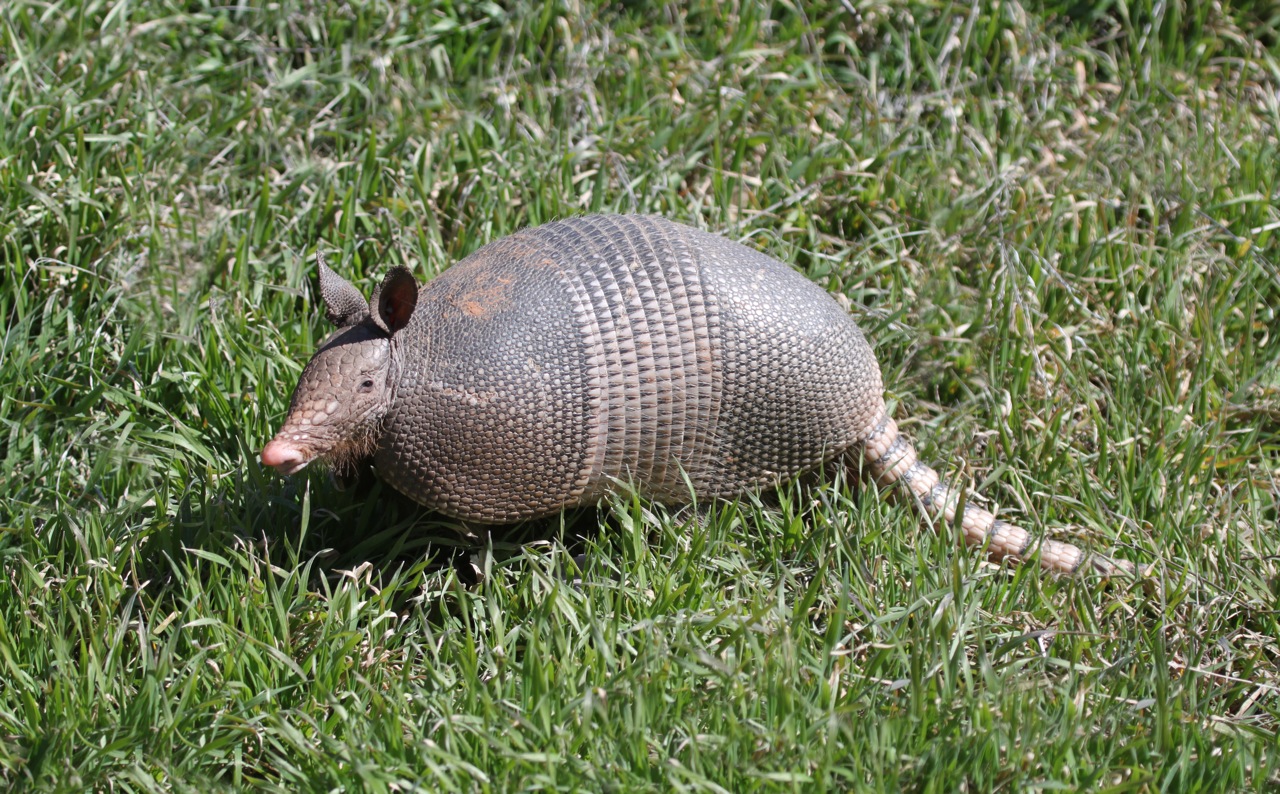Armadillos (Spanish for little armoured one) are New World nocturnal mammals covered by a leathery armour shell overlaid by horn. Of all living animals, “few are as amazing … as the armadillos” (Storrs, 1982). Even Carolus Linnaeus, the father of taxonomy, was puzzled about how to classify this “strange-looking mammal” (Smith and Doughty, 1984, p. 2). They are shy, timid mammals that mammalogist David Lamp calls bizarre (1977, p. 36). They look nothing like any other living animal, appearing much more like a fierce miniature dinosaur. These nearly blind and deaf animals must use their keen sense of smell to locate food.
Their origin has baffled Darwinists, and evolutionists today are stymied about where they came from because we have nary a clue about how they ever could have evolved. A key problem for armadillo evolution is their mosaic of animal traits, ranging from insects to mammals. Armadillos are said to have eyes like a pig, a tail like a rat, ears like a mule, armoured scales like an alligator and a carapace (shell) like a turtle (Helder, 1991, p. 31). As Smith states, they are “an endless collection of oddities” (Smith, 2014, p. 124).
In spite of its many oddities, the “armadillo is an ecological success story” that thrives throughout much of the South, Southwest, and Central America (Smith and Doughty, 1984, p. ix). Armadillos are, along with the two other strange animals, anteaters and sloths, part of the superorder Xenarthra. About ten extant genera and twenty extant species have been described, some which are distinguished merely by the number of bands on their armor. The smallest armadillo species is roughly chipmunk-sized and the largest is about the size of a small pig.
Armadillos have five clawed toes on their hind feet, and three to five toes with heavy claws on their forefeet. They use their sharp claws both to dig for food, including insects, grubs, and other invertebrates, as well as for making deep underground burrows to live in. Although they thrive in a variety of environments, the most common type, the nine-banded armadillo, prefers to build its burrows in moist soil near the creeks, and streams around which it lives and feeds (Macdonald, 1984).
Their armour plates consist of relatively small, overlapping epidermal scales composed of bone with a hard horn covering that has the distinct appearance of a turtle shell (Macdonald, 1984, p. 780). Most species are covered with these rigid plates separated by flexible skin to allow some movement. The plates cover their back, shoulders, hips, top of their head, the tail, and the upper parts of their limbs. Their underside is covered with soft skin and fur (Macdonald, 1984, p. 780). If evolution had occurred, their armour progression from pre-armour state to their present design would be critical to document this claim.
Many evolutionists assume the major reason their armour-like covering evolved is for defense, but it is less important for many armadillos then escaping predators by fleeing or hiding in dense brush. Armadillos have short legs, but can rapidly scurry from enemies. Some species can roll up into an almost perfectly round ball, but most have too many plates to protect themselves in this way (Macdonald, 1984, p. 19). Armadillos’ main enemies, aside from humans, were once coyotes, foxes and wild dogs, the populations of which are now far less.
The many major design changes that would be required if they had evolved from a non-armoured mammal range from major respiration and thermoregulation alterations, to significant mechanical changes that enable these hard plate covered animals to breathe, to escape enemies, and even to reproduce (Superina, and Loughry, 2012, p. 217)
For example, although due in part to their low rate of metabolism, they have the ability to remain under water for as long as six minutes, about twice as long as most mammals their size. Because of their armour’s high density, armadillos must swallow air to inflate their stomach to twice its normal size so as to raise their buoyancy above that of water. This allows them to swim across narrow streams and ditches.
If one accidentally falls into a creek, it sinks to the bottom and slowly walks out of the water (Smith, 2014, p. 124). This ability is another unique trait for a mammal, requiring significant evolutionary changes to evolve from a non-armed mammal. In cold climates they have a system to trap air beneath their shell that reduces heat loss so effectively that they can survive comfortably on cold winter days (Macdonald, 1984, p. 783).
Armour plates and turtle shells are unique features that are comparatively well preserved in the fossil record in contrast to soft parts and small thin bones such as we see in birds. Indeed, hard parts are critical fossil evidence. Considering how well their armour is preserved, if they had evolved, good evidence of this fact should be found in the fossil record.
Like parasitoid wasps, certain flatworms, and a few aquatic invertebrates, the armadillo genus Dasypus uses a very unusual reproductive system called polyembryony, which involves producing four genetically identical offspring from a single egg (Hamlett, 1933; Loughry, et al., 1998). But this trait is not advantageous because it reduces genetic diversity and, if the egg contains a deleterious mutation, all four babies will have the defect (Smith, 2014, p. 126). While excellent for scientific research that requires subjects with identical biological and genetic makeup, scientists have failed to address the origin of this major evolutionary problem (Smith, 2014, p. 126).
Another indication of their uniqueness is the fact that armadillos, along with mangabey monkeys and rabbits, are among the very rare species that can contract leprosy (Watson, 1989). Armadillos are particularly susceptible to this disease due to their unusually low body temperature, 34 °C, which allows the leprosy bacterium, Mycobacterium leprae, to thrive.
The literature is almost totally silent on armadillo evolution scenarios, rarely even attempting to speculate on how they could have evolved from some non- armadillo ancestor. The fact is, the relationship of armadillos to other mammals is obscure due to the absence of fossil intermediates (Engleman, 1985, p. 52). The armadillo has been called a “living fossil” (Lampe, 1977, p. 36) because it shows no evidence of significant change in the fossil record. Speculation involves the supposition that they evolved about 130 million years ago in South America.
A major problem for evolution is that the armadillo shell plates, which were fully formed in the earliest known armadillo fossils, making it “the most heavily armored modern mammal that has ever existed (Patterson and Pascual, 1968, p. 423). Zoologist Smith writes of their contrast with all other life forms, arguing that if evolution is true, they must have had a very long evolutionary history, yet no fossil evidence exists, and evolutionists do not even have a plausible scenario as to their origins (Smith, 2014, p. 125). We should see evidence in the lower fossil record of the beginning of the evolution of their shell. Higher in the fossil record, a larger more advanced shell should exist. Then next in the fossil record, a yet larger shell should be found until the modern shell that covers almost the entire animal is present today. No hint of this progression has ever been seen in the fossil record.
Armadillos are very fecund animals that live in large areas of the North and South American continents. Enormous numbers of armadillos exist today, and have existed in the past. Even if only one out of a million were fossilized, they should be common in the fossil record. Furthermore, the fossil record of mammals in South America is “very good,” another reason why clear evidence of armadillo evolution should exist, if it had occurred (Patterson and Pascual, 1963, p. 410).
An extinct animal called Glyptodon has a similar armour covering that looks somewhat like a cross between a turtle and an armadillo, but also no evidence of its evolution exists in the fossil record. Glyptodonts were enormous animals about the size of modern automobiles. Another example is Utaetus, claimed to be a primitive armadillo, but actually is probably a palaeanodont, the largest surviving armadillo whose fossil record is also blank (Patterson and Pascual, 1963, p. 422). With so many remarkable characteristics, we surely will regard the armadillo with new appreciation. Their shell, that appears so weird or funny looking, is actually an amazing feature and an embarrassment to evolution theory.
Engelmann, George. 1985. “The Phylogeny of the Xenarthra.” In Montgomery, pp. 52-64.
Hamlett, G.W.D. 1933. The Quarterly Review of Biology, 8 (3): 348–358, September.
Helder, Margaret. 1991. Creation Ex Nihilo, 13(4):32-34, September-November.
Lampe, David. 1977. National Wildlife, 15(2): 34-37, February-March.
Loughry, W.J et al. 1998. American Scientist, 86(3):274–279, May-June.
Macdonald, David (editor). 1984. The Encyclopedia of Mammals. New York: Facts on File, pp. 781–783.
Montgomery, G. Gene (editor). 1985. Evolution and Ecology of Armadillos, Sloths, and Vermilinguas. Washington and London: Smithsonian Institution Press.
Patterson, B., and R. Pascual. 1968. Quarterly Review of Biology, 43(4):422–423.
Smith, E. Norbert. 2014. Evolution: A Theory in Question. San Bernardino, CA: Shook Publisher.
Smith, Larry L. and Robin W. Doughty. 1984. The Amazing Armadillo. Austin, TX: University of Texas Press.
Storrs, Eleanor E. 1982. National Geographic, 161(6):820-830, June.
Superina, M., and W. Loughry. 2012. Journal of Mammalian Evolution, 19(3):217-224.
Watson, Jim. 1989. National Wildlife, 27(6):47-49, October-November.
Dr. Jerry Berman
June 2015
Subscribe to Dialogue







